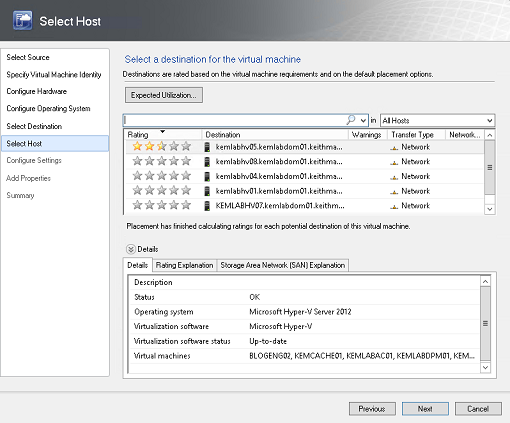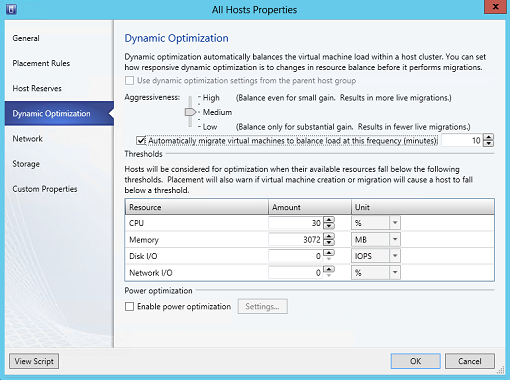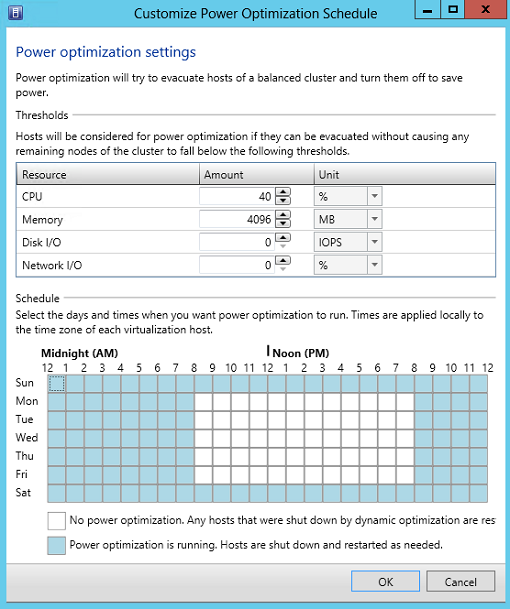VMware or Microsoft? Automated Server Workload Balancing for Heterogeneous Private Clouds
VMware vSphere 5.x includes automated server workload balancing in the vSphere Enterprise and Enterprise+ premium suites via two feature sets: Distributed Resource Scheduler (DRS) and Distributed Power Management (DPM). DRS and DPM together are intended to provide an automated method for balancing compute capacity and reducing energy consumption in a highly virtualized datacenter. It does this by addressing five key technical areas:
 |
Automated Server Workload Balancing …
|
These capabilities are important to ensure that an organization is efficiently leveraging virtualization host capacity in a manner that provides greatest performance benefits while reducing ongoing operating costs. However, research has shown that 65% to 70% of organizations are running more than one hypervisor. As a result, it’s necessary to provide these capabilities universally on every hypervisor platform in use – not on just the most expensive editions of a single hypervisor.
In this article, we’ll briefly describe each of these key technical areas and contrast with how these same capabilities are delivered in Windows Server 2012, our FREE Hyper-V Server 2012 enterprise-grade bare-metal hypervisor, and System Center 2012 SP1 Virtual Machine Manager (VMM) across multiple hypervisors in a heterogeneous Private Cloud. As we discuss each area, you’ll also see that some of these capabilities are integrated into the core of Windows Server 2012 and Hyper-V Server 2012, and as such, those capabilities can be delivered at significantly less cost for organizations seeking to standardize on Hyper-V.
Initial Workload Placement and Constraint Correction
When you provision a virtual machine in a VMware vSphere 5.x Enterprise or Enterpise+ environment, Distributed Resource Scheduler (DRS) selects a recommended virtualization host based on available CPU and memory capacity and resource requirements. DRS evaluates the CPU & memory load across a vSphere cluster every 5 minutes to update the current cluster conditions. To use DRS, a vSphere cluster must be created and DRS must be enabled on this cluster. Affinity and anti-affinity rules can be configured to ensure that VMs are placed appropriately across DRS host groups for constraint correction. Note that if using VMs enabled for VMware Fault Tolerance (FT), DRS will not be used during initial workload placement, as noted here. DRS is configured and managed via a separately purchased VMware vCenter Server management console, which is capable of managing up to 500 hosts and 5,000 VMs when using its included management database.
In System Center 2012 SP1, Virtual Machine Manager (VMM) provides intelligent placement of VMs for Hyper-V, VMware vSphere and Citrix XenServer virtualization hosts. More than just CPU and memory load, intelligent placement takes into account CPU, memory, storage and network loads to prepare an aggregate “rating” for each Hyper-V host. Intelligent placement recalculates this rating every 10 minutes to update current host conditions. Intelligent placement is configured and managed via a VMM management server, which is included in the System Center 2012 suite at no additional cost. VMM is capable of managing up to 1,000 hosts and 25,000 VMs when using its included management database.
System Center 2012 SP1 Virtual Machine Manager – Intelligent Placement
In terms of affinity and anti-affinity rules for constraint correction, Windows Server 2012 and the free Hyper-V Server 2012 includes built-in support for preferred cluster resource owners and anti-affinity VM placement rules as part of the native Hyper-V Host Clustering capabilities. These capabilities can also be managed via System Center 2012 VMM if desired, but there’s no required additional cost for these core capabilities.
Automated VM Load Balancing
In a VMware vSphere 5.x Enterprise or Enterprise+ environment, DRS can be configured to perform automated VM load balancing by setting the DRS automation level to Fully Automated for VMware vSphere clusters. For load balancing, DRS leverages vMotion to move running VMs between clustered vSphere hosts, and as such requires that vMotion be enabled on each host with a dedicated vMotion network. Since vMotion is not compatible with VMs that are clustered using Windows Server Failover Clustering (documented here), automated DRS is not supported on these VMs. Configuration and management of both vMotion and DRS automation levels are performed via the separately purchased VMware vCenter Server.
In System Center 2012 SP1, Virtual Machine Manager (VMM) supports automated VM load balancing via the Dynamic Optimization feature set for Hyper-V, VMware vSphere and Citrix XenServer hosts. Dynamic optimization can be configured for fully automated operation and leverages the live VM migration capabilities in each virtualization platform to move running VMs between hosts. For Windows Server 2012 or Hyper-V Server 2012 hosts, live VM migration is compatible with VMs clustered with Windows Server Failover Clustering when using hardware and software certified for clustering – note that depending on network IO loads, you may also need to configure VM guest clusters for relaxed monitoring. Configuration and management of Dynamic Optimization is performed via System Center 2012 VMM, an included component of System Center 2012.
System Center 2012 SP1 Virtual Machine Manager – Dynamic Optimization
In terms of Live Migration of VMs, as my friend and colleague Matt Hester noted in his recent article, both Windows Server 2012 and Hyper-V Server 2012 include native support for Live Migration of VMs across clustered hosts and non-clustered hosts at no additional cost. Live Migration can also be managed and leveraged from within the System Center 2012 VMM management console, but for Windows Server 2012 and Hyper-V Server 2012 it’s not required for core Live Migration capabilities.
Power Management
In a VMware vSphere 5.x Enterprise or Enterprise+ environment, Distributed Power Management (DPM) can be configured to reduce power consumption for vSphere hosts within a DRS cluster by powering hosts on and off based on cluster resource utilization thresholds. DPM seeks to consolidate VMs on a smaller number of vSphere hosts than currently powered on by leveraging vMotion to move running VM’s between hosts and using baseboard management controllers to manage server power on/off actions. Since DPM relies on vMotion for mobility of running VMs within a DRS cluster, DPM has the same vMotion requirements and limitations as noted above in the Automated Load Balancing section of this article. Like DRS, DPM is managed via the separately licensed VMware vCenter Server.
In System Center 2012 SP1, Virtual Machine Manager (VMM) supports power management of Hyper-V hosts, VMware vSphere hosts and Citrix XenServer hosts with a baseboard management controller via the Power Optimization feature set. Like DPM, Power Optimization also seeks to reduce power consumption in the datacenter by Live Migrating running VMs to a smaller number of physical virtualization hosts during non-peak periods of utilization. After consolidation is successful, hosts not currently needed are safely powered down and then powered up at a later point-in-time if needed for additional host capacity.
System Center 2012 SP1 Virtual Machine Manager – Power Optimization
Cluster Maintenance
In VMware vSphere 5.x Enterprise or Enterprise+, DRS and VMware Update Manager can work together to safely place vSphere cluster hosts into maintenance mode for applying necessary host updates without unnecessary VM downtime. Like the other DRS features, this is all managed via the separately licensed VMware vCenter Server management console.
In System Center 2012 SP1, Virtual Machine Manager (VMM) can be leveraged to set and unset maintenance mode on the following clustered virtualization hosts: Hyper-V, VMware vSphere and Citrix XenServer. In addition, while updates can be applied to Hyper-V hosts via the VMM management console, Windows Server 2012 and Hyper-V Server 2012 include a native Cluster Aware Updating (CAU) capability that systematically applies updates in a cluster-safe manner … at no additional cost.
You’ll find additional details on CAU in the following article:
Summary
In summary, research has shown that 65% to 70% of business organizations are currently leveraging more than one hypervisor for supporting virtualized workloads in their datacenter. To gain the highest value and efficiency from this investment, enterprise IT teams require the ability to dynamically manage and balance server workloads across this multi-vendor virtualization fabric.
Both VMware vSphere and Microsoft Private Cloud solutions provide key features for automating server workload balancing in highly virtualized environments. However, VMware’s solution requires an investment in more expensive premium editons of vSphere, namely Enterprise and Enterprise+ editions, and the additional cost of vCenter Server to provide these capabilities. In addition, VMware’s solution provides these capabilities only across homogeneous VMware vSphere hypervisors that are configured in a DRS cluster- forcing many customers into using alternate point solutions for automated workload management of their other hypervisor platforms.
Microsoft Private Cloud solutions, including Windows Server 2012, free Hyper-V Server 2012 and System Center 2012 SP1, provide workload placement and balancing across a heterogeneous hypervisor environment, consisting of Hyper-V, VMware vSphere and Citrix XenServer hypervisor hosts. In addition, core capabilities for delivering certain key features related to this mission, such as affinity/anti-affinity settings, Live Migration and Cluster Aware Updating (CAU), are provided at no additional cost as part of the native virtualization capabilities in Windows Server 2012 and free Hyper-V Server 2012, further reducing costs for organizations that are looking to standardize their hypervisor platform on Hyper-V.
Even if you are currently running VMware vSphere Enterprise or Enterprise+ premium editions today, Microsoft Private Cloud solutions provide an easy path forward for extending automated server workload balancing to the other hypervisor platforms within your datacenter environment.
Additional resources you may be interested in …
- FREE EBOOK: Get Started as an “Early Expert” on Windows Server 2012 R2
- Build Your Private Cloud in a Month
- VMware or Microsoft? FREE Orchestrated Patch Management for Continuous Availability with Hyper-V Server 2012
- VMware or Microsoft? Reducing VMware Storage Costs WITH Windows Server 2012 Storage Spaces
- VMware or Microsoft? Protect Private Clouds with Site-to-Site Failover using Hyper-V Replica and Windows Azure HRM
- Safely Virtualizing and Cloning Active Directory Domain Controllers with Windows Server 2012 - Step-by-Step
- VMware or Microsoft? The Complete Series



